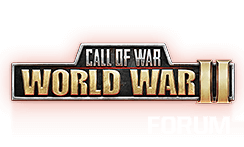In an effort to help new players, I am going to periodically post a series of topics called "Rookie Mistakes," which will discuss obvious tactical and strategic errors that are common among many new players (and some experienced ones, too). This second post will discuss the consequences of not understanding the different movement speeds of the various unit types.
Let's start with the basic premise that speed matters. Generally speaking, faster is better, and getting to a destination before your enemy does, or before your enemy can reinforce a weak unit formation, or send troops to an un-garrisoned province, can be the difference between an easy victory and a costly battle. Weaker, but faster units may escape being destroyed by stronger, but slower enemy units (destroyers vs. battleships; armored cars vs. medium tanks). Weaker, slower units may be run down and destroyed by faster, stronger units (infantry vs. tanks). So, yes, speed does matter.
One of the most fundamental tactics employed in Call of War is combining several units into what is commonly called a "stack," or in more proper military terminology, a "formation." Intuitively, most beginning players understand that a stack of multiple units is stronger than a single unit, and a stack not only allows the player to multiply the strength of combining, say, 5 infantry regiments (5 times stronger than one infantry regiment), but also to combine multiple units of different types (say, 5 infantry regiments, 3 light tank brigades, 3 anti-aircraft regiments, and an anti-tank regiment) to take advantage of their different strengths against enemy infantry, armor and aircraft. So far, so good. But most rookies ignore the fact that these units move at different speeds, and when different types of units are combined into a single stack, they will all move at the speed of the slowest unit in the stack. When getting somewhere before your opponent does is the most important concern, then speed matters most.
As an example, the fastest unit in the game is the armored car brigade ("AC"); a level 1 AC unit has a top speed of 45 kmh, and AC units get faster with each additional level of research completed up to 75 kmh. The slowest unit in the game is the militia regiment; all militia units (L1-L7) have a top speed of 15 kmh. Thus combining an AC unit with a militia unit will reduce the speed of the AC unit by two thirds. If you're in a hurry to get somewhere, that's not the way to do it when speed matters.
Every unit's speed, by research level, is listed on the unit spec sheets. If haven't read the unit spec sheets, and aren't referring back to them on a regular basis, you may be left wondering why your opponents are running circles around you. Reading the instructions may be the key to victory. . . .
Let's start with the basic premise that speed matters. Generally speaking, faster is better, and getting to a destination before your enemy does, or before your enemy can reinforce a weak unit formation, or send troops to an un-garrisoned province, can be the difference between an easy victory and a costly battle. Weaker, but faster units may escape being destroyed by stronger, but slower enemy units (destroyers vs. battleships; armored cars vs. medium tanks). Weaker, slower units may be run down and destroyed by faster, stronger units (infantry vs. tanks). So, yes, speed does matter.
One of the most fundamental tactics employed in Call of War is combining several units into what is commonly called a "stack," or in more proper military terminology, a "formation." Intuitively, most beginning players understand that a stack of multiple units is stronger than a single unit, and a stack not only allows the player to multiply the strength of combining, say, 5 infantry regiments (5 times stronger than one infantry regiment), but also to combine multiple units of different types (say, 5 infantry regiments, 3 light tank brigades, 3 anti-aircraft regiments, and an anti-tank regiment) to take advantage of their different strengths against enemy infantry, armor and aircraft. So far, so good. But most rookies ignore the fact that these units move at different speeds, and when different types of units are combined into a single stack, they will all move at the speed of the slowest unit in the stack. When getting somewhere before your opponent does is the most important concern, then speed matters most.
As an example, the fastest unit in the game is the armored car brigade ("AC"); a level 1 AC unit has a top speed of 45 kmh, and AC units get faster with each additional level of research completed up to 75 kmh. The slowest unit in the game is the militia regiment; all militia units (L1-L7) have a top speed of 15 kmh. Thus combining an AC unit with a militia unit will reduce the speed of the AC unit by two thirds. If you're in a hurry to get somewhere, that's not the way to do it when speed matters.
Every unit's speed, by research level, is listed on the unit spec sheets. If haven't read the unit spec sheets, and aren't referring back to them on a regular basis, you may be left wondering why your opponents are running circles around you. Reading the instructions may be the key to victory. . . .
The post was edited 3 times, last by MontanaBB ().
